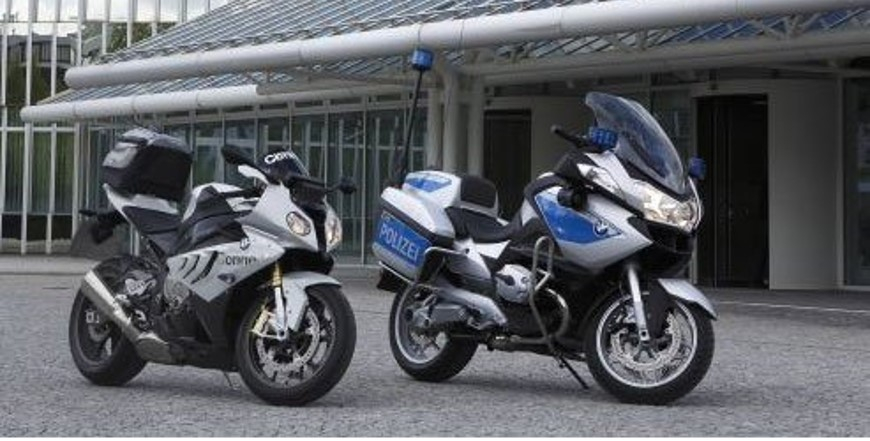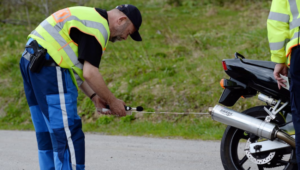
Cars and motorcycles talk to each other in research project demonstrating new ways to safer and more efficient mobility. Motorcycles from manufacturer BMW Motorrad were part of simTD, a wide field project involving 120 vehicles and spanning over four years.
Motorcycles from manufacturer BMW Motorrad were part of simTD, one of the world’s biggest field trials for Car-to-X communication spanning over four years of research and using more than 120 test vehicles. Car-to-X technology was put to the test for the first time in real traffic conditions on motorways and major highways as well as urban routes in and around Frankfurt am Main. “The BMW Group was the only project partner to involve both cars and motorcycles in the field trial,” explains Dr Christoph Grote, Head of BMW Group Research and Technology.
Active protection also for motorcyclists.
Integrating motorcycles into bidirectional vehicle communication is a particularly important aspect of Car-to-X communication. BMW Motorrad ConnectedRide is BMW’s research strand focussing on enhancing safety for motorcyclists. A key element of the project here was the development of rider assistance systems based on Car-to-X communication. Out on the road motorcyclists face other dangers than motorists do. Certain situations, such as fog, slippery roads or heavy rain, pose far more of a challenge to motorcyclists than to car drivers. And due to their slim silhouette, bikers unfortunately are frequently overlooked. It can therefore be of great benefit to motorcyclists if they and the car drivers sharing the road are made aware of each other’s presence in good time.
Watch the video {youtube}QdTdp7jTEhI{/youtube}
Intelligent driving that saves energy and enhances safety always means anticipating what lies ahead as well. Car-to-X communication allows the driver to look a long way ahead, see things that are hidden, and even peer around several corners. Since the potential of Car-to-X communication can only be fully exploited through mass use, the only real benefit is to be gained by researching this technology in alliance with other partners. That is why, four years ago, numerous companies from the automotive and telecoms sectors, the federal state government of Hessen, the city of Frankfurt am Main and a number of well-known universities and research institutes came together to work on the research project simTD (Safe and Intelligent Mobility – Test Field Germany). Their shared objective was to test Car-to-X technology in actual traffic. The results of this project were presented in the concluding presentation in Frankfurt am Main on June 20th.
In Car-to-X communication, vehicles and infrastructure are electronically linked to each other. This allows direct communications between vehicles as well as between vehicles and the traffic infrastructure, such as traffic light signals. Car-to-X communication takes place via wireless LAN or mobile network connections. The ad-hoc communication is based on high-speed WLAN, which is derived from the high-frequency WLAN standard IEEE 802.11p or ITS G5A and allows real-time communication. The protocol is structured so that many subscribers can communicate with each other in parallel. At the same time, mobile communication networks are becoming increasingly powerful, with higher bandwidths and even shorter delays – or latency times – in data transmission. As such, they are playing an increasingly important role in Car-to-X communication, e.g. as a means of supplementing WLAN communications.
The simTD research project.
simTD is a joint project between leading German carmakers, car suppliers, telecommunications companies and research institutes. The project partners are: Adam Opel AG, AUDI AG, BMW AG – BMW Forschung und Technik GmbH, Daimler AG, Ford Research Centre Aachen, Volkswagen AG, Robert Bosch GmbH, Continental Teves AG & Co. oHG, Deutsche Telekom AG, Fraunhofer Society for the Advancement of Applied Research, German Research Centre for Artificial Intelligence (DFKI), Technical University of Berlin, Technical University of Munich, Saarland University of Applied Sciences, University of Würzburg, Hessen Mobile – Road & Traffic Management, city of Frankfurt am Main. The project was funded and supported by the Federal Ministry of Economics and Technology (BMWi), the Federal Ministry of Education and Research (BMBF) and the Federal Ministry for Transport, Building and Urban Development (BMVBS) as well as the state of Hessen, the German Association of the Automotive Industry (VDA) and the Car 2 Car Communication Consortium.
Further information can be found at http://www.simTD.de.



